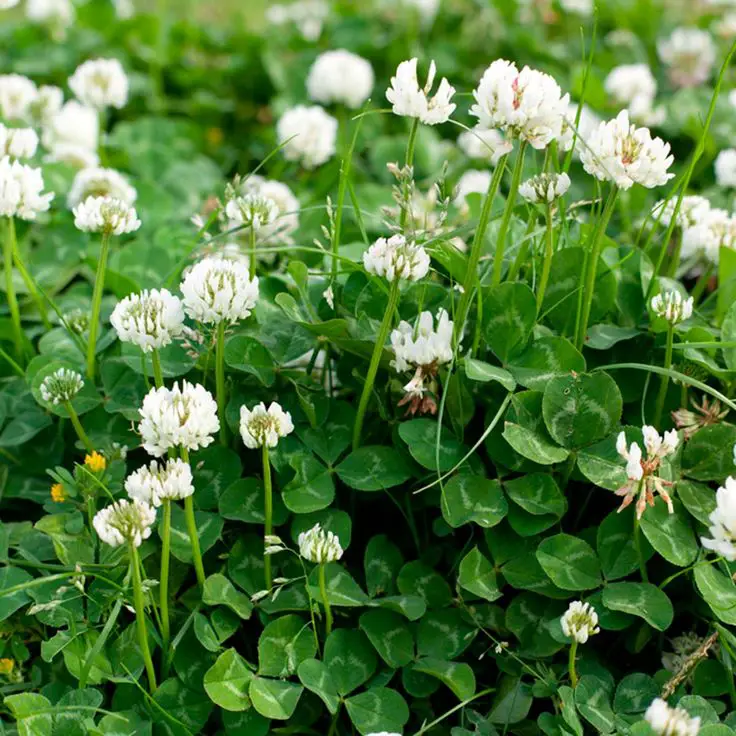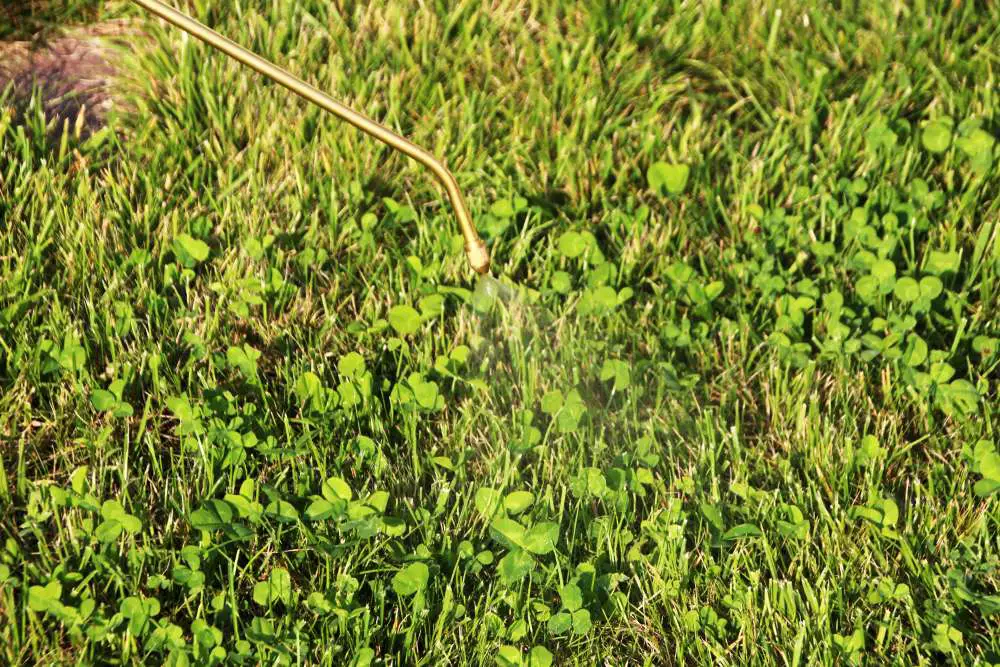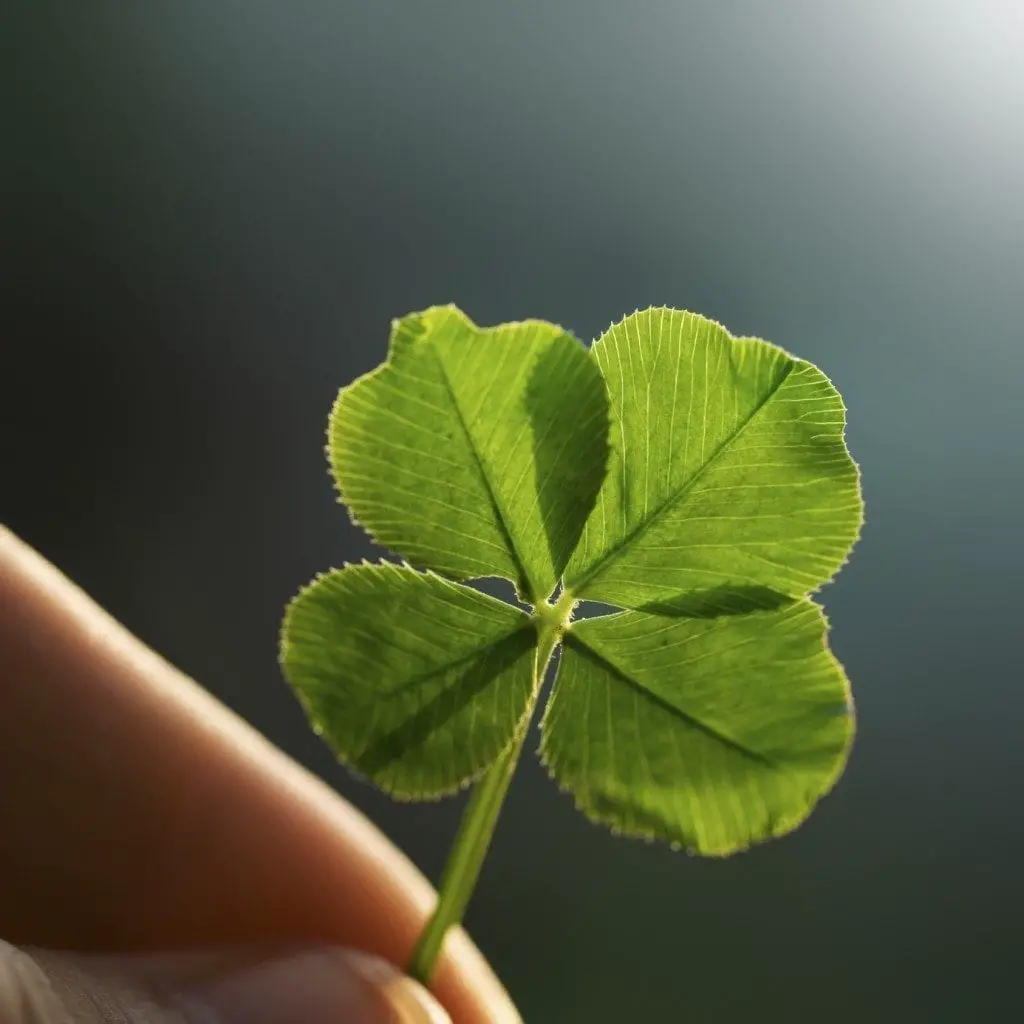Remove Clover By Mower
If the clover is sufficiently raised from the soil and your mower is set to a very low setting, it might be possible to rip the clover out of the soil. This will be quite destructive to the grass, so be prepared to have a bare spot on your lawn. Damping the soil six hours before mowing may help the mower remove the clover as it will loosen the roots from the soil.
Remember to collect any clover clippings in your mower box so to prevent the spread of the weed to other areas of your lawn and garden.
Keeping Clover Out Of Your Lawn
Once you have got rid of clover in your lawn, you can tweak your lawn care regime so that your lawn becomes a no-go area for this particular invader.
Start with feeding your lawn. Clover prefers low fertility soil so regularly applying the right lawn feed for the time of year will make the area less attractive to this plant species.
Raise the height of the cut. Maintaining your lawn at around 4-8cm long will help the grass to thrive and outcompete unwanted plants.
Hold back on irrigation. Established lawns really dont need too much water. Many plant nutrients dissolve in water and are easily washed away. The more you water your lawn, the more chance there is of reducing soil fertility and creating the conditions that clover loves. Please dont let new lawns dry out though.
Dig out clover plants as soon as you see them, dont let them get a foot hold in your lawn.
You May Like: How Do You Fix Bare Spots In Your Lawn
How Do You Get Rid Of Clover In Your Lawn
Clover is a legume that is grown and used as hay for wildlife. There are over 300 species of clover, but the most common are white, red, and strawberry clovers. Clover can also be grown on the lawn because it is a perennial plant and requires little maintenance and can therefore be a good alternative to grass.
However, most lawn owners consider it a weed and prefer to get rid of it. You can remove clover from the lawn by pulling it manually, using herbicide, corn gluten, or vinegar.
Recommended Reading: How To Turn My Lawn Green
You May Like: How To Remove All Weeds From Lawn
How To Get Rid Of White Clovers Without Destroying The Lawn
Before you try any fertilizer to kill clover-like A.D.I.O.S. clover killer, there is something else you should be aware of. No fertilizers or weed killers come without side effects.
You should think of a natural way whenever you wonder how to get rid of white clovers without destroying the lawn. And its not that hard to achieve without ruining your lawn.
So in this article, I will show you many ways of killing clover without damaging your precious lawn. Stay with me.
Why Do You Have So Much Clover In Your Lawn

Clover is a perennial plant that grows aggressively. It thrives wherever it finds a favorable condition. Contrary to common perception, clover is also beneficial to your garden.
For example, the white clover has a broadleaf and grows along with common grass. It can grow in more robust areas such as poorly drained soil or too shady areas where other vegetation may find it challenging to grow.
The other species of clover is red clover that grows taller than white clover and blooms small purple flowers. Clover is a natural fertilizer as it contains bacteria that convert nitrogen into the fertilizer.
This ability of clover to fix nitrogen from the air allows clover to grow in nitrogen-poor soil. While other plants may struggle to grow properly due to low nitrogen in the ground, the clover finds space and less competition to thrive in any harsh environment.
Aggressive growth of clover in your lawn may indicate the nitrogen deficiency in the soil. This deficiency may be due to inherent poor soil quality, use of excessive fertilizers, over-irrigation, or low temperature.
You may find clover growing in lawns that arent well kept or undernourished.
Improving the soil quality and nutrient level for your lawn care encourages the other plants to grow and reduces the ability of clover to grow unchecked.
Also Check: How To Get Rid Of Brown Patches On Lawn
Mow Your Lawn Higher Than 3 Inches
Clover is a low-growing plant with a shallow root system. Consequently, it does not grow as tall as the surrounding grass. If you set your mowers deck to three inches or higher, it will keep your grass higher than your clover, thus depriving the weed of sunlight.
While you might like the look of a close-cropped lawn, such a deep cut can harm your plants health. As a rule, cut no more than one-third off your grass during a single mowing session. Set your mowing height and your calendar accordingly.
Donât Miss: How To Kill Clover Grass In Your Lawn
Fertilise Your Lawn To Remove Clover
Provide the correct nutrition for your lawn, and it will thrive preventing the space for clover and weeds from taking root.
I recommend fertilising your lawn three-to-four times a year that way, it will develop density and vitality. This means that clover has nowhere to go.
Fertilise in the spring, early summer, late summer, and autumn.
Recommended Reading: How Do I Get Rid Of Lawn Gnats
What Does Clover In My Lawn Mean
In most cases, when you see clover growing in your lawn it means that there isnt enough nitrogen. Clover is a legume plant, much like beans, lucerne or alfalfa, that actually draws nitrogen from the air, which it stores in its roots. When the roots die back, the soil draws in the nitrogen. But when your lawn already has enough nitrogen, the clover starts to struggle.
Clover growth can also be a sign that your lawn has been mown too short, is underfed or has been overwatered. All of these issues can be addressed by practising proper lawn care.
Lsa Fertiliser Premium Lawn Food
We recommend you use a high NPK fertiliser, specifically one with high levels of nitrogen, phosphorus and potassium. The LSA Fertiliser Premium Lawn Food is a good option and is going to improve the overall health and growth of your lawn while making it a nitrogen-rich environment that clover wont be able to stand.
Just remember to always read the label for the best advice on application rates and be sure to water-in well after spreading on your lawn. We guarantee that after one or more applications your lawn should be in great condition, with significantly less clover action.
Recommended Reading: Does Five Point Amphitheater Have Lawn Seats
Will Weed Killer Remove Clover In Lawns
If you donât want to leave your clover to grow, and the methods above donât seem to be making a dent in the invasion, then it may be time to call in the best weed killers.
According to the RHS, white clover is relatively susceptible to weed killer with dicamba and mecoprop-P, and may be eliminated after one or two applications.
Lesser yellow trefoil , however, is tougher to get rid of with most lawn herbicides, as is birds foot trefoil, another clover-like species. Look for products containing fluroxypyr to tackle it.
The RHS adds how applying weed killer after August can be less effective. âAs the majority of clovers found in lawns self-seed freely, further applications the following spring will inevitably be required.â
And if youâre looking for an alternative to traditional weed killers? âDuring late spring, apply a liquid iron,â says David. He explains how the natural product will stress the leaf blades, allowing the grass to outcompete it. These organic products can work for eradicating moss and dandelions from lawns, too, and they wonât damage the grass itself.
Whatever weed killer you go for, just be sure to follow the instructions carefully on the label, and keep them out of reach of children and pets.
How To Get Rid Of White Clover: Controlling Clover In Your Lawn
Heres some good news: as weeds go, white clover isnt that bad. Its pretty easy to control, it gives you dainty white flowers, and attracts cute frolicking bunnies.
Seed companies actually used to include clover seed in their lawn mixes on purpose. Clover takes nitrogen out of the air and soil and makes it available to your lawn. But its still a weed. So, how do you get rid of white clover in your lawn? Lets take a look.
Don’t Miss: Where Can I Take My Lawn Mower To Get Fixed
Why Some People Want Clover In Their Lawn
On a side note, it might surprise you to know that some people actually choose to add clover to their lawn. This is due to the fact that clover prevents weeds, fertilises your lawn by adding nitrogen, attracts bees, is soft to walk on, makes your lawn appear greener and shades the soil well. In fact, back in the 1950s and 60s, the optimum lawn mix was around 20% clover. For all these reasons, many people encourage the growth of clover in their lawn and even add in additional microclover to give more uniform clover coverage.
However, if you prefer the look of a smooth, velvety lawn without the distraction of clover flowers and wide leaves, youll need to thoroughly remove this prolific weed. Heres how to do it.
Dutch White Clover Lawn Cover

Some homeowners use Dutch Clover as a lawn cover instead of grass. Its fibrous root systems and ability to handle a lot of foot traffic and mowing make it somewhat ideal. There are some big downsides to consider, however, before opting for a weed-like clover lawn over grass. Read on before you decide to plant white clover seed.
Also Check: How To Add Calcium To Lawn
How Do I Control White Clover In My Lawn
How do I control white clover in my lawn?
White clover is a creeping perennial. It is a common plant in many Iowa lawns because it is a prolific seed producer and adapts well to mowing and other lawn care practices. Its presence is often a sign of low nitrogen fertility.
White clover in lawns can be controlled through proper fertilization and the application of broadleaf herbicides. Late April/early May, mid-September, and late October/early November are excellent times to fertilize Kentucky bluegrass lawns in Iowa. Broadleaf herbicide products that contain 2,4-D, MCPP, dicamba, or triclopyr provide good control of white clover. Fall applications are more effective than late spring or summer applications.
Dont Miss: How Much Does Tru Green Cost
Adjust Your Mowing Height
Mowing over clover with a lawnmower is a temporary way to control clover growth. Most people think that lowering their mowers height, so it sits closer to the ground is the most effective way to control clover. The opposite is true.
Clover is a low-growing weed and offers a shallow root system. Allowing your grass to grow taller blocks the sunlight clover needs to grow.
Read Also: What To Use For Top Dressing Lawn
Improve The Quality Of Your Turf
The most important factor in learning how to get rid of lawn weeds of all kinds is to ensure your grass is healthy. As David Hedges Gower, the founder of the Lawn Association says, clover is normally a sign of a poorly maintained lawn. For instance, it particularly thrives in nitrogen-poor ground.
There are, however, some simple steps you can take to improve the conditions of your turf and the soil beneath.
David says to start by looking at your soil. âCheck the pH and see if itâs suitable to be growing grass,â he says. In most cases, the optimal level is between 6.0 and 7.0. Soil that is too acidic can make it difficult for grass to grow, and easier for some types of clover. It can be balanced with soil amendments, such as lime.
Also, âcheck your compaction levels,â says David. âClover often does well in poor soils that are very compacted, so start to hollow tine aerate your lawn at least once a year.â
Whatâs more, if youâre creating a new lawn by planting grass seed, and want to reduce the risk of clover invading it, ensure you pick a good species that is weed-free. Itâs worth paying extra for a better quality mix.
âFeed the lawn using a high-quality lawn feed to further enhance the grass,â he adds. You can find more spring lawn care tips and autumn lawn care tips in our guides.
Improving the conditions of your lawn will help the grass, rather than the clover, to grow stronger
How Does Clover Spread
Clover spread is a type of software that allows users to create spreadsheets for any purpose. The spreadsheet can be used to track expenses, income, or anything else that needs to be tracked. Clover spread also has a feature called cluster which allows users to group similar data together. This makes it easier to analyze the data.
Recommended Reading: How Do You Get Rid Of Nutsedge In Your Lawn
Getting Rid Of Red Clover In The Lawn
From April to October, the deep-rooted perennial red clover brings a touch of colour to lawns with its purple flowers. It thrives in similar conditions as white clover. So to control it, you can use the same methods of using nitrogen-rich and phosphate-poor fertiliser, digging out individual plants and covering them with a light-excluding material. Red clover not only has deep roots, requiring deeper digging for removal, but it also grows quite tall to anywhere from 15 to 80 cm. It can easily be kept short with a lawn mower. Take care not to cut the entire area too short though, as this will weaken the lawn and make it easier for the red clover to reproduce and spread further. A good cutting length is 4 to 5 cm.
Overview: Red clover
- Dig out red clover plants
- Mow red clover to weaken it
- Cover the affected areas
Why You May Want To Keep Clover In Your Lawn
You may not like the look of clover, but it can actually benefit your lawn.
- Natural Fertilizer: Clovers symbiotic relationship with beneficial bacteria allows it to absorb nitrogen from the atmosphere. Ultimately, it can make your lawn greener and more lush. However, this will keep it growing and outcompeting your grass.
- Weed Prevention: Mowing your lawn high will prevent weeds from growing, including clover. But if you like short, neat grass thats under 3 inches, letting clover flourish is a solid option. Clovers leaves cast shade over the soil, making it hard for other weeds to take root and grow and compete with your grass.
Also Check: What Time Of Day Should I Fertilize My Lawn
What Causes Clover To Grow In Your Lawn
A few things that can cause clover to grow in your lawn include the following:
- Compacted soil: Clovers thick root system lets it grow in tightly compacted soil that grass cannot root in.
- Lack of nitrogen in the soil: Clover thrives in nitrogen-poor dirt.
- Over-fertilization in one area: In this case, clover may thrive in one area while grass grows in another.
- Poor drainage: Clover can flourish in nearly any soil, including poorly drained areas where grass will not grow.
If you experience any of these problems in your lawn, youll need to address them before you can get rid of your cloverthat is, if you want to get rid of it.
Killing Actively Growing Clover With Post Emergent Herbicides

Post-emergent synthetic herbicides are one of the most effective clover control methods. This news might not be favorable for homeowners who prefer a more natural approach to lawn care, but unfortunately, its the truth.
They work to destroy actively growing weeds by either attacking the foliage or making their way through the plants vascular system to destroy the roots. Selective herbicides are carefully formulated to control specific types of weeds or weed categories , so they wont harm your grass when applied correctly.
The following 4 broad-leaved herbicides are highly recommended on Amazon if you are looking for a highly effective post-emergent product for controlling clover. They are all selective formulas formulated to target actively growing clovers and other broadleaf weeds.
| Preview |
|---|
Recommended Reading: How To Make Your Lawn Look Great
Control In Vegetable Gardens
Cultural Control: It is best to treat weeds before tilling the soil for a vegetable garden. Tilling can break up and spread weed seed and perennial weed rhizomes throughout the garden plot. Some methods used to remove weeds in the vegetable garden include hand pulling, mulching, soil solarization, fall cover crops, and post-emergent herbicides.
Hand-pulling white clover is only practical for small garden plots. If hand pulling is chosen, be sure to work when the soil is moist so that the roots can be removed easily from the soil.
Organic mulch can be used in the garden to help suppress white clover development. Before laying the mulch, apply a layer of 6 to 8 newspaper sheets to act as a weed barrier. Wet the newspaper layer to prevent weed development by blocking light to the weeds underneath and preventing their growth. Best of all, the newspaper should decompose before next spring. To prevent low oxygen levels in the root zone, keep organic mulch levels at a maximum of 3-inches deep. If triclopyr, atrazine, metsulfuron, or 2,4-D containing products are applied to lawns for weed control, do not use the clippings for mulch in vegetable gardens or around ornamentals, as plant injury or death may result. For more information on mulching the vegetable garden, see HGIC 1253, ControllingWeeds by Cultivating and Mulching. For information on fall cover crops to suppress white clover, see HGIC 1252, Cover Crops.
You May Like: How To Remove Fungus From Your Lawn